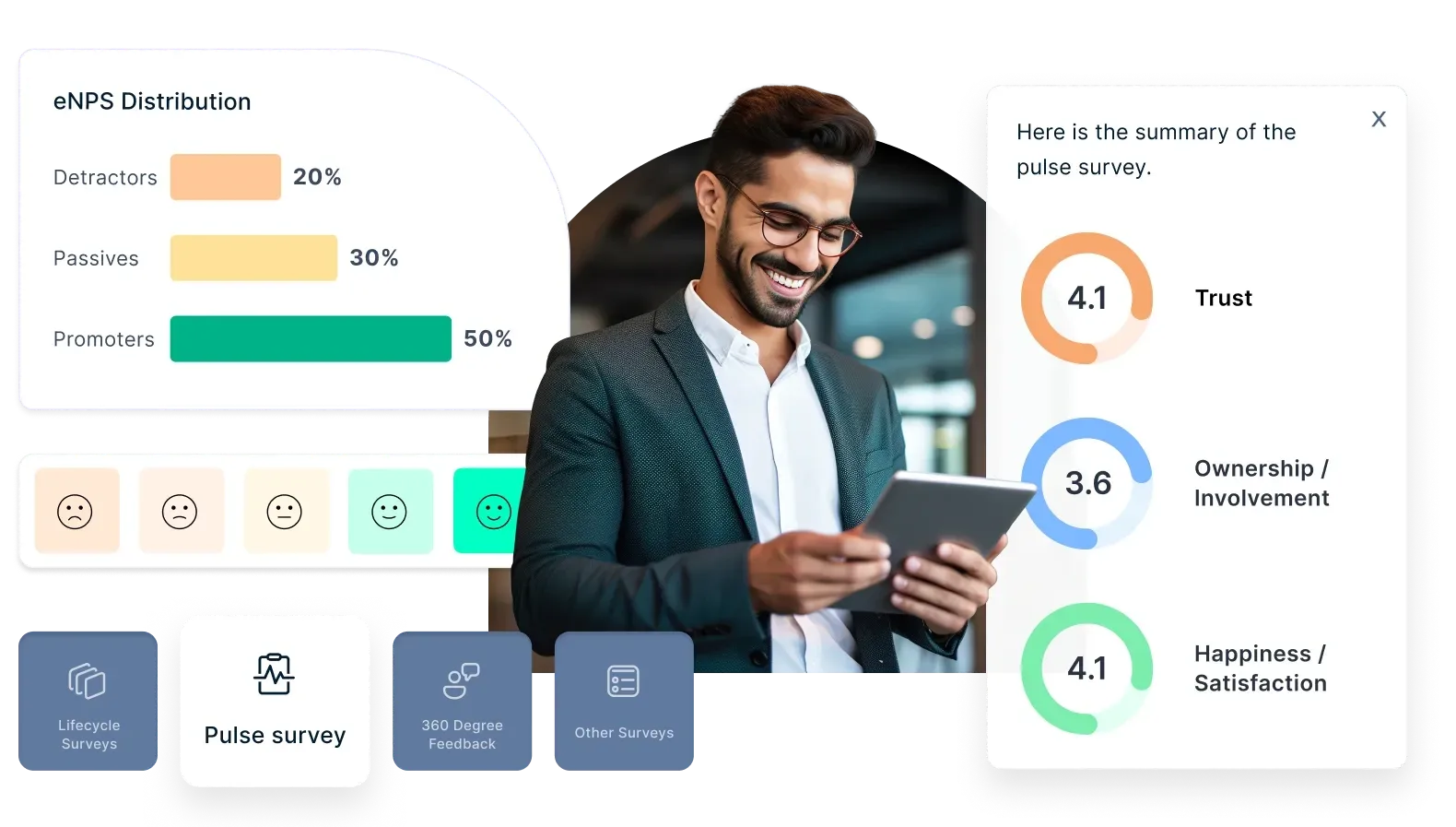150 Performance Review Examples and Phrases for Giving Effective Feedback
Providing structured feedback is essential for employee growth. This blog covers performance review examples, phrases, and questions to help managers conduct meaningful evaluations. From constructive feedback to recognition phrases, these insights ensure fair, professional, and productive reviews.
On this page
Employee performance reviews are crucial for all businesses. They let managers or supervisors assess their staff members' work and offer them insightful, constructive, and honest employee feedback on their:
- Strengths
- Skills
- Efficiency
- Areas of improvement
Employee engagement is also largely dependent on performance reviews. Therefore, you should know the appropriate words or phrases or employee performance review examples to use during a performance evaluation.
Complicated and wordy messages can confuse both the reviewer and the reviewee and, thus, detract from clarity.
However, if you do it appropriately, performance reviews can promote your employees' professional growth by reinforcing good habits, rectifying undesirable behaviors, and inspiring them to perform better.
Therefore, to help you comprehend better, we’ve curated a list of 150 performance review phrases and questions. But before we go through the list, let's briefly understand what a performance review is.
What is a performance review?
A performance review is a standardized assessment in which employers or managers analyze an employee's work performance in order to determine their merits and flaws. They can also provide feedback and help with setting personal and organizational goals.
Reviewing the performance of employees is a critical aspect of running a business. It helps to improve the efficiency and productivity of your employees. Effective performance reviews can also help employers accomplish the following:
- Adequately distribute raises or pay increases
- Assist team members in acquiring new skills
- Outline the goals and expectations of the company
Based on the business capacity and size and the goals of the assessments, each company's review procedure may vary in frequency and complexity. The performance review assessments can be carried out either yearly or quarterly.
150 Useful performance review phrases
Below is a list of 150 performance review phrases and examples that you can use based on the position, function, or personality of the employee in question:
1. Teamwork
Here are 9 positive examples of performance review phrases for teamwork:
- Willing to be counted on by their teammates and expect the same in return
- Develops strong relationships in a professional setting with coworkers, superiors, and other staff members
- Provides support to teammates on their tasks, even though they are not directly responsible for them or obliged to help
- Exemplifies a culture of collaboration on a daily basis
- Readily collaborates with their coworkers to accomplish the goal
- Exceptionally adept at motivating team members to bring out their best effort.
- Oversees the team's operations and delegates tasks to team members appropriately.
- Built a highly motivated team that collaborates to commence and finish the task on or before the deadline
- Always willing to assist teammates who are going through a tough time with their responsibilities
Here are 9 negative examples of performance review phrases for teamwork:
- Seems more concerned about achieving their targets than helping anyone who might require some assistance
- Struggles to acclimatize after transferring from a sector that is very autonomous to one that is team-oriented
- Although an expert, they tend not to provide professional guidance or assistance to those who may need
- Struggles with completing assignments while collaborating with others
- Doesn't care enough to inspire team members to perform at their highest level while working
2. Attendance
Here are 7 positive examples of performance review phrases for being attentive :
- Replies to emails and attends calls of stakeholders on time
- Attend conferences, workshops, and seminars on time at all times
- Always arrive on time for work each day
- Completed X years of flawless attendance
- Consistently available even when their division's work schedule is unrelated to it
- Follows the schedule and plan as accurately as attainable
- Always shows up on time, sticks to the schedule, and takes lunch breaks as scheduled
Here are 6 negative examples of performance review phrases for being attentive:
- Attends far too many personal phone calls on a daily basis
- Routinely goes past their allotted lunch break, affecting their productivity
- Does not adhere to the attendance requirements set forth by the organization
- Shows up at work late on a regular basis
- Consistently exceeds the allotted number of leaves
- Must learn to arrive timely after scheduled leaves
3. Interpersonal skills
Here are 8 positive examples of performance review phrases for good interpersonal skills:
- Has strong interpersonal skills and needs little to no instruction in communicating well with others
- Possesses the ability to deal with sensitive circumstances promptly and efficiently
- Can hear and effectively comprehend verbal and nonverbal indications from coworkers
- Ensures that their teammates are comfortable with a decision made by a higher authority
- Is an excellent team player who enjoys working with others
- Possesses the ability to resolve team conflicts
- Has the capability to collaborate with colleagues to resolve conflict in a respectful manner
- Possesses the ability to communicate clearly with people from different cultures, places, etc.
Here are 5 negative examples of performance review phrases for good interpersonal skills:
- Refuses to take constructive criticism from coworkers that can help them grow in the corporate world
- Interacts with coworkers in an abrasive and unprofessional manner
- Refuses to take any initiative or incorporate constructive suggestions made by coworkers
- Reacts defensively to constructive criticism
- Appears uneasy when questioned during team meetings
4. Communication skills
Here are 7 positive examples of performance review phrases for good communication skills:
- Adept at efficiently conveying complex messages and decisions
- Routinely offers constructive criticism
- Communicates complex subjects to the rest of the team in a transparent and understandable manner
- Asks interesting and meaningful questions
- Not afraid to answer when confronted with a difficult question
- Is skilled at summarizing and conveying critical business decisions
- Is open to hearing other people's opinions
Here are 7 negative examples of performance review phrases for communication skills:
- Stands out from their colleagues for having excellent employee communication skills
- Repeatedly berates staff members
- Has difficulty interacting effectively in teams
- Instead of doing it themselves, ask other coworkers to convey bad news
- Does not adequately notify supervisors of progress updates
- Does not provide constructive feedback on new initiatives
- Regularly engages in awkward conversations and occasionally becomes territorial
5. Achievement
Here are 8 positive examples of performance review phrases for achievement:
- Sets realistic goals and actively works to meet them
- Surpassed the benchmark by X%, outperforming other team members
- Reduced the time it took to resolve complaints to 24 hours, which boosted customer retention by X%
- Employed effective SEO strategies and increased the site's organic traffic by X%
- Implemented a strategy that works well to optimize work processes
- Working cooperatively with a team was improved by X%
- Generated X% more revenues at the end of the last quarter compared to the previous one
- Used automation tools to save the organization $1 million
Here are six negative examples of performance review phrases for achievement:
- Last month's goal was missed by X%
- Would benefit from reviewing their own failures and successes each quarter
- Failure to meet commitments due to a lack of coordination
- Would prosper from defining career goals
- Finds it challenging to provide error-free work consistently
- Improved social media interaction is essential to boost organic traffic
6. Innovation and creativity
Here are seven positive examples of performance review phrases for innovation and creativity:
- Frequently comes up with fresh, creative answers to handle difficult situations
- Thinks creatively and unconventionally
- Always encourage or assist teammates in coming up with innovative ideas
- Their creative capabilities are a valuable contribution to the company
- Has a strong imagination and routinely offers some of the most original ideas
- Uses creative thinking to carry out a vision for the business
- Consistently offers fresh ideas during meetings and when working on projects
Here are 7 negative examples of performance review phrases for innovation and creativity:
- Could provide alternative strategies for resolving problems
- Could take the initiative to work on new projects
- Their problem-solving methods are typically inflexible and conventional
- Prefers a traditional, cautious approach to problems rather than a creative one
- Could perform better in places that require innovative solutions
- Might use some creative thought
- Too reluctant to take chances on coming up with creative solutions
- Has a habit of rejecting projects that require creative thinking
7. Leadership
Here are nine positive examples of performance review phrases for leadership:
- Encourages team members to put in a good effort
- Establishes a safe environment for team members to express their thoughts and perspectives
- Recognizes the capabilities of teammates and effectively assigns work
- Keeps team focused and engaged in work
- Expresses sincere appreciation for a job well carried out
- Actively hear what their coworkers are suggesting and respond appropriately to it
- Is an excellent role model for others to emulate
- Encourages the development of an understanding- and learning-centered corporate culture
- Always ready to lend a hand to a teammate
Here are 7 negative examples of performance review phrases for leadership:
- Ambiguous while deciding which objectives and tasks to accomplish
- Seldom acknowledges a successfully completed task with praise or positive feedback
- Regularly causes the team to fall behind with superfluous activities
- Rejects team members' opinions or suggestions
- Does not treat other staff members equally with respect
- Always overanalyzes situations when a speedy resolution is demanded
8. Attitude
Here are seven positive examples of performance review phrases for attitude:
- Has a positive outlook that encourages their teammates to do better
- Always optimistic in every situation
- Quickly smiles and boosts morale in tense situations
- Always cheer up coworkers
- Does not allow difficult situations to dampen their spirit
- Always comes to work with a cheerful demeanor
- Keeps a persistent, optimistic attitude that motivates others
- Helps others have a positive attitude toward challenges by sharing ideas and thoughts that are constructive
- The way they behave shows how much they like their work
- Fosters a culture of trust among staff members
Here are seven constructive/negative examples of performance review phrases for attitude:
- Has an attitude toward causing problems
- Gets upset easily and shows a pessimistic attitude
- Must learn to accept constructive feedback
- Gets easily distracted or provoked by non-work topics
- Behavior at work exhibits bipolar tendencies
9. Time management
Here are 9 positive examples of performance review phrases for time management:
- Has the capacity to finish tasks, particularly those with tight deadlines
- Shows an excellent capacity for coordinating several tasks and projects simultaneously
- Efficiently utilizes free time
- Effectively manages a variety of tasks and projects without requiring heavy supervision
- Is adept at handling multiple tasks quickly and with precision
- Manage their time quite well
- Consistently fulfills all goals on time
- Creates brief and time-saving presentations
- Schedules meetings on time
Here are 5 negative examples of performance review phrases for time management:
- Fails to meet deadlines despite being granted plenty of time to finish all assigned tasks
- Has trouble coordinating multiple tasks and initiatives
- Does not efficiently manage their work schedule time
- Lacks the ability to efficiently prioritize tasks
- Shows a tendency to let personal matters influence how well they function at work
10. Productivity
Here are 10 positive examples of performance review phrases for productivity:
- Consistently surpasses performance benchmarks
- Has incredibly high standards for productivity
- Have a track record of delivering work at a high caliber
- Constantly looking for ways to be more effective
- Encourages people to perform efficiently at work by maintaining a positive attitude
- Consistently goes above and beyond expectations and delivers the best result
- Significantly contributes to the business's ongoing expansion
- Places a high value on details, which is evident in their work
- Share their understanding of market trends and best practices with the team to assist them in achieving better results
- Is a key contributor to the organization's success
Here are five negative examples of performance review phrases for productivity:
- Requires to pay greater attention to the intricacies before turning in a project
- Finishes the more straightforward tasks first instead of prioritizing the urgent ones
- Doesn't accomplish their work by the required productivity standards
- Should engage in more training and development activities to advance their knowledge and abilities
- Work performance and productivity have been below par lately
11. Accountability
Here are five positive examples of performance review phrases for accountability:
- Accepts accountability for one's actions and contributions as a team member, as well as involvement in the organization's growth
- Respect deadlines and take responsibility for them
- Acknowledges shortcomings and notifies colleagues when unable to uphold a commitment
- Takes accountability for the part they play in project management
- Unwilling to be complacent with errors and finds resolutions for them
Here are three negative examples of performance review phrases for accountability:
- Must accept responsibility for meeting deadlines
- Rejects responsibilities for fixing errors
- Fails to communicate effectively regarding delayed deliverables

Simplify Feedback with Performance Review Phrases
Use structured performance review examples and phrases to deliver meaningful feedback. Strengthen evaluations, motivate employees, and drive better results.
62 Important employee performance review questions you must ask
Here are 62 most essential employee performance review questions.
Employee performance review questions giving information about the employee's overall performance
1. What accomplishments are you most proud of for this quarter?
2. What are the ideal working conditions to be most productive?
3. What goals have you achieved?
4. What motivates you to finish your work?
5. What can we do to make your job more enjoyable?
6. Which goals seem short?
7. What was your greatest achievement at work?
8. What do you hope to achieve next year?
9. Performance Appraisal Questions: About Employee Strengths
10. What skills do you have that you think we could use more effectively?
11. Tell us about your strengths that help you do your job effectively.
12. What makes you a suitable fit for your position?
13. Which job is easiest for you?
14. Describe what work inspires you the most.
15. What skills or knowledge do your team members hope to provide you?
Employee performance appraisal questions about potential areas for improvement
16. What goals/accomplishments were you least proud of? why?
17. How do you plan to do them differently in the future?
18. What 2-3 things will you focus on next quarter to help you grow and develop?
19. What can we do to better achieve your goals?
20. Where do you think there is room for improvement?
21. Performance Appraisal Questions: Information about the employee's current role
22. What tasks/tasks do you enjoy the most?
23. What job duties do you like best?
24. What do you like best about your current role?
25. What would you change about your current role?
26. How do you think your role will help the company succeed?
27. What do you like most about working at our company?
Employee performance review questions about future growth and prospects
28. What are your main goals for the next quarter?
29. What is your biggest challenge for the coming year? how do you prepare for it?
30. Are your personal goals aligned with the goals of the organization? if not, why?
31. What is your next role in this company?
32. What professional growth opportunities would you like to explore to get there?
33. How would your responsibilities change?
34. Which career growth is most important to you?
35. Which position in the company do you want to move to next?
Employee performance review questions about relationships with managers or other employees
36. What (if any) concerns do you have about giving feedback?
37. How can I alleviate these concerns?
38. How would you like to receive feedback and/or recognition for your
work?
39. Did you get enough valuable feedback this quarter?
40. What are two or three things I could do differently to manage you better?
41. What do I do that most/least helps you do your job?
42. How have I helped you achieve your goals in the past months?
43. What can we do to improve our relationship?
44. What would you do differently if you were a manager?
45. Does the team feel they work well together?
46. Where has management helped and hindered your work?
47. What would colleagues or clients say about their recent interactions with you?
Employee performance review questions about company's culture and values
48. What are the main factors of the company's success?
49. Which of our company values have you lived best in the past months?
50. Are you satisfied with our company culture and are there areas that need improvement?
51. What is your favorite thing about working at our company?
52. How can we make our company more inclusive and diverse?
53. When did you feel proud to be part of our company?
Employee performance review questions for managers
54. Here are the best review questions for managers:
55. What role does [name] play on the team and what impact has it had?
56. Describe a significant contribution that [name] made this quarter
57. What company value have you seen [name] emulate well over the past few months?
58. Describe how you contributed to the success and growth of [name] What projects did [name] excel at?
59. How successful has [name] been in creating and achieving goals in recent months?
60. What are the focus areas/projects that [name] could benefit from?
61. How has [name] contributed to the company's current goals [win more contracts, launch new campaigns, etc.]
62. What positive interactions have you noticed between [name] and others?

Conduct Better Performance Reviews with Ease
Access performance review phrases and questions to ensure fair and productive evaluations. Provide actionable feedback and foster continuous improvement.
Effective employee performance metrics during feedback
Accurate performance metrics are essential for meaningful appraisals. Metrics should align with the employee’s role and be prepared in advance to ensure structured feedback. Keeping track of key performance indicators throughout the year helps avoid missing critical contributions during evaluations.
A well-executed performance review delivers feedback effectively while ensuring employees understand their strengths and areas for improvement. The right words, tone, and body language play a crucial role in how feedback is received. Many reviews fail due to poor execution, but it’s never too late to refine the process.
Inspired by James E. Neal, Jr.’s Effective Phrases for Performance Appraisals, performance metrics are categorized under key functional and technical skills below to help provide constructive feedback.
1. Productivity & production
One of the all-time favorite performance categories, productivity, is now used as a performance indicator for a wide range of functions. This is perhaps even the most significant of all categories from' lines of code per day to revenue.
Productivity denotes the effectiveness of output, and these metrics are how the business measures this effectiveness.
Below given are a few productivity metrics for performance review:
- Delivered X against the target of Y in Z time.
- Overachieved by A%.
- Consistent performance for X months in succession.
- They are contributed to overall revenue by X%.
- Improved productivity by introducing process improvements.
2. Quality
Quality metrics are critical for all business processes and functions. A quality metric shows the desired adherence to a product or service. The manager can re-defined this degree based on the feasibility of adherence to expectations.
A value is attributed to the 'quality' of an offering, and a tolerance value is defined. For example, a performance objective of budget utilization could be set as an objective ± 20%. Here the quality is the actual budget utilized, and it is acceptable if within + or -20% of the planned budget.
Below given are a few quality metrics for a performance discussion:
- Enhanced quality score to X%.
- Achieved the overall process quality by Y%.
- Handled escalation within time.
- SOPs are maintained in detail.
3. Attendance
Managing employee attendance is one of the company's strategic priorities because this metric directly affects productivity.
Actions to reduce employee absences are essential so that workers are consistently present to do their jobs, working productively for the organization's benefit.
Attendance as a critical metric for reviews can help control and regulate absenteeism.
Following are a few attendance metric suggestions:
- Your punctuality is commendable.
- Shift and roster adherence are at X%.
- Maintains balance between breaks and work timing.
- Plan your schedule.
4. Delivery
Delivery metrics are used to track the project execution effectiveness and to put a tag on the delivery of various business-facing services. There are many tools to capture these metrics, such as satisfaction surveys, completion measurements, and other data from your performance management system.
Below are a few delivery metrics for the performance review:
- Well-handled delivery
- Completed the task within the timeline.
- Maintained the quality of delivery.
- Demonstrated good teamwork.
5. Program/Project Management
Program metrics help track project execution, budget, quality, risk, and overall effectiveness. Key performance indicators include:
- Maintained control over project scope and timelines
- Took full ownership and accountability
- Planned and executed phased delivery effectively
- Ensured detailed documentation and requirement gathering
- Made informed decisions in critical project phases
- Communicated assertively with clients on realistic timelines
- Fostered strong collaboration with teams and stakeholders
- Found innovative solutions to customer issues
- Provided real-time feedback for continuous improvement
- Ensured effective use of communication channels
These metrics help assess leadership, execution, and problem-solving within project management.
6. Communication
The way an employee enables effective two-way communication with the manager and peers is vital to have a productive work environment and relationship.
It is essential to consider this category as a metric to encourage people to communicate more effectively.
Below are a few metrics for communication:
- Communicate.
- Effectively drive open and transparent communication.
- Facilitate two-way interaction between the team and the leadership.
- Cascade information in a timely manner.
- Document discussion in a detailed manner.
- Enable brainstorming and sharing of ideas within the team.
- Use the available channels of communication optimally.
7. Timeliness
Adhering to timelines is a golden rule for all functions with tasks whose deliveries are entirely dependent on the employees. Even for other parts, having value for time is essential to work effectively - like being timely during sales meetings, demos, or client calls.
Below are a few timeliness metrics:
- Maintain focus on timelines.
- Consistent in timely delivery.
- Respect others' time.
- Maintains schedules.
- Optimal utilization of time.
- Prioritize and pick up assignments.
- Well planned day to own additional responsibilities.
8. Credibility
Most importantly, displaying credibility is critical to maintaining brand trust and equity for client-facing functions and others. For nurturing a healthy organizational culture, values that show credibility need to be encouraged to put into action.
Below are a few credibility metrics:
- Display values in action.
- Work with integrity and discipline.
- Strengthened relationships with client and internal stakeholders.
9. Leadership/People Management
Effective leadership fosters a supportive work environment and enhances team performance. Key leadership metrics include:
- Lead by example and drive the team with focus
- Balance people management and processes effectively
- Encourage learning, mentorship, and career growth
- Maintain composure in critical situations
- Foster strong relationships with internal stakeholders
- Define clear KRAs aligned with organizational goals
- Recognize and reward employee contributions on time
- Delegate effectively while maintaining accountability
- Leverage team strengths and share credit
- Communicate proactively and engage in team-building activities
Strong leadership ensures a motivated workforce and a high-performing team.
10. Innovation
Critical for organizations to remain agile, relevant, and responsive to the market environment, employees need to innovate. Including innovation as a performance metric encourages employees to disrupt processes and products.
Below are a few innovation metrics:
- Focuses on finding innovative ways for problem-solving.
- The disruptive approach is enabled in certain areas.
- That was a clever way of assisting the client.
- Drives innovative thinking.
- Has done great in creating awareness around innovation and sustenance.
- Has been a major contributor to the idea portal.
11. Self-learning & personal excellence
The extent to which the employee is independent in acquiring new skills and knowledge signifies how engaged and motivated the employee is to excel in their role. The personal excellence metric helps include learning as an essential priority for employees.
Below are a few self-learning and personal excellence metrics:
- Completed X% of the laid down learning target.
- Promotes the learning culture.
- Took up mentoring/job shadowing initiative.
- Completed additional responsibilities assigned.
- Display capabilities of higher duties.
- Show potential for critical deliveries.
- Enhancing knowledge as per organization requirements.
12. Solution-oriented
Are employees actively seeking to solve problems for internal and external customers? This solution orientation is vital for the business to create real value for their buyers.
Below are a few metrics on this front:
- Focus on resolving the matter.
- Approaches a problem with a solution mindset.
- Analyze a situation for possible solutions.
- Perform detailed Root cause analysis.
- Guides the team in crisis.
13. Going beyond the call of duty
Organizations need their employees to exhibit exceptional organizational citizenship behavior (OCB). If they are always ready to go beyond their call of duty, it indicates that they are working at their highest potential.
It is essential to add these behaviors as a performance indicator to encourage them.
Below are a few metrics that relate to OCB:
- Successfully deliver delegated tasks.
- Took up additional responsibilities.
- Live organization values.
- Contribute towards the organization's objectives.
- Help others achieve their goals.
- Participate in organization-level initiatives.
- Collaborate and execute with ease.
- It aims at continuous learning and improvement.
- Share ideas with others.
Make performance reviews more meaningful with Empuls

Effective employee performance reviews are essential for fostering growth and enhancing productivity. Empuls offers tools to streamline and enrich this process, ensuring comprehensive and insightful evaluations.
- Gather comprehensive feedback: Utilize Empuls' 360° feedback surveys to collect input from managers, peers, and subordinates, providing a well-rounded view of an employee's performance.
- Leverage data-driven insights: Empuls' HR People Analytics delivers in-depth employee engagement and performance metrics analyses, enabling informed decision-making during evaluations.
- Monitor engagement levels: Implement pulse surveys to regularly assess employee sentiment, allowing for timely interventions and support to maintain high performance.
Integrating Empuls into your performance review process ensures evaluations are thorough, objective, and conducive to employee development.
Final words
The performance review phrases and performance review examples in this blog help managers provide constructive feedback while ensuring a fair and professional evaluation. Tailoring these phrases to each employee highlights strengths and areas for improvement, fostering growth and engagement.
However, some employees may not align with the organization's goals, and a structured performance review process helps identify underperformance for smoother transitions.
Another way to gather insights about your employees is through the employee engagement surveys feature from Empuls. The employee survey tool from Empuls was created with professionals from the Society for Human Resource Management (SHRM). It offers you real-time, intuitive, and actionable insights. It also suggests actionable solutions to address issues generating disengagement and focus on areas for improvement.
So what are you waiting for? Sign up for Empuls today for a free 30-day trial to begin discovering and enjoying all of its features!


















